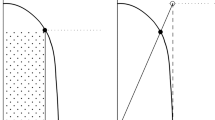Concluding remarks
Logically satisfactory methods for narrowing the range of social choice can be designed. For example, the SDF which transforms (S, R) into P(S, R), that is, the Pareto rule, satisfies all the conditions imposed on C(·) in Theorem 9: The Pareto rule is normal. For if x ∈ P(S, R) and y ∈ S, then y cannot be Pareto superior to x; so x ∈ P({x, y}, R), and α2 is satisfied. If x ∈ S and x ∈ P({x, y}, R) for all y ∈ S, no y in S is Pareto superior to x, and therefore, x ∈ P(S, R); so γ2 is satisfied. The Pareto rule is clearly neutral and anonymous; it is unbiased among the alternatives and among the individuals. The Pareto rule is obviously non-imposed. The Pareto rule is nonmanipulable. For if xP iy, P({x, y}, R) must be either {x} or {x, y}. If P({x, y}, R) = {x, y}, there is an individual j ≠ i for whom yR jx. Consequently no misrepresentation by i can force y out of the set of optima, and therefore the rule is cheatproof.
The significance of this paper is that any rule which is logically satisfactory (in the sense of the conditions of Theorem 9) must be bracketed between the maximal and Pareto rules. So those rules are especially important: they provide lower and upper bounds for completely satisfactory multi-valued SDFs.
Similar content being viewed by others
References
Arrow, K.J. Social Choice and Individual Values, 2nd ed. New York: John Wiley and Sons, 1963.
Barberá, S. ‘Manipulation of Social Decision Functions.’ Journal of Economic Theory 15 (1977), pp. 262–278.
Blau, J.H., and Deb, R. ‘Social Decision Functions and the Veto.’ Econometrica 45 (1977), pp. 871–879.
Brams, S.J., and P.C. Fishburn. ‘Approval Voting.’ American Political Science Review (forthcoming).
Feldman, A.M. ‘Optimality and Manipulability of Collective Choice Rules.’ Working Paper No. 77-24, Brown University, Department of Economics, 1977.
Gärdenfors, P. ‘Manipulation of Social Choice Functions.’ Journal of Economic Theory 13 (1976), pp. 217–228.
-- ‘On Definitions, of Manipulation of Social Choice Functions,’ in J.J. Laffont, ed,, Aggregation and Revelation of Preferences. North-Holland, 1978.
Bibbard, A. ‘Manipulation of Voting Schemes: A General Result.’ Econometrica 41 (July 1973), pp. 587–601.
Kelly, J.S. ‘Strategy-Proofness and Social Choice Functions Without Singlevaluedness.’ Econometrica 45, no. 2 (1977), pp. 439–446.
May, K.O. ‘A Set of Independent, Necessary and Sufficient Conditions for Simple Majority Decisions.’ Econometrica 20 (1952), pp. 680–684.
Satterthwaite, M.A. ‘Strategy-Proofness and Arrow's Conditions: Existence and Correspondence Theorems for Voting Procedures and Social Welfare Functions.’ Journal of Economic Theory 10 (1975), pp. 187–217.
Schmeidler, D., and Sonnenschein, H. ‘Two Proofs of the Gibbard-Satterthwaite Theorem on the Possibility of a Strategy-Proof Social Choice Function,’ in Proceedings of a Conference on Decision Theory and Social Ethics. Reidel Publishing Co., forthcoming.
Sen, A.K. ‘Social Choice Theory, A Re-examination.’ Econometrica 45 (1977), pp. 53–89.
Author information
Authors and Affiliations
Rights and permissions
About this article
Cite this article
Feldman, A. Nonmanipulable multi-valued social decision functions. Public Choice 34, 177–188 (1979). https://doi.org/10.1007/BF00129525
Issue Date:
DOI: https://doi.org/10.1007/BF00129525




